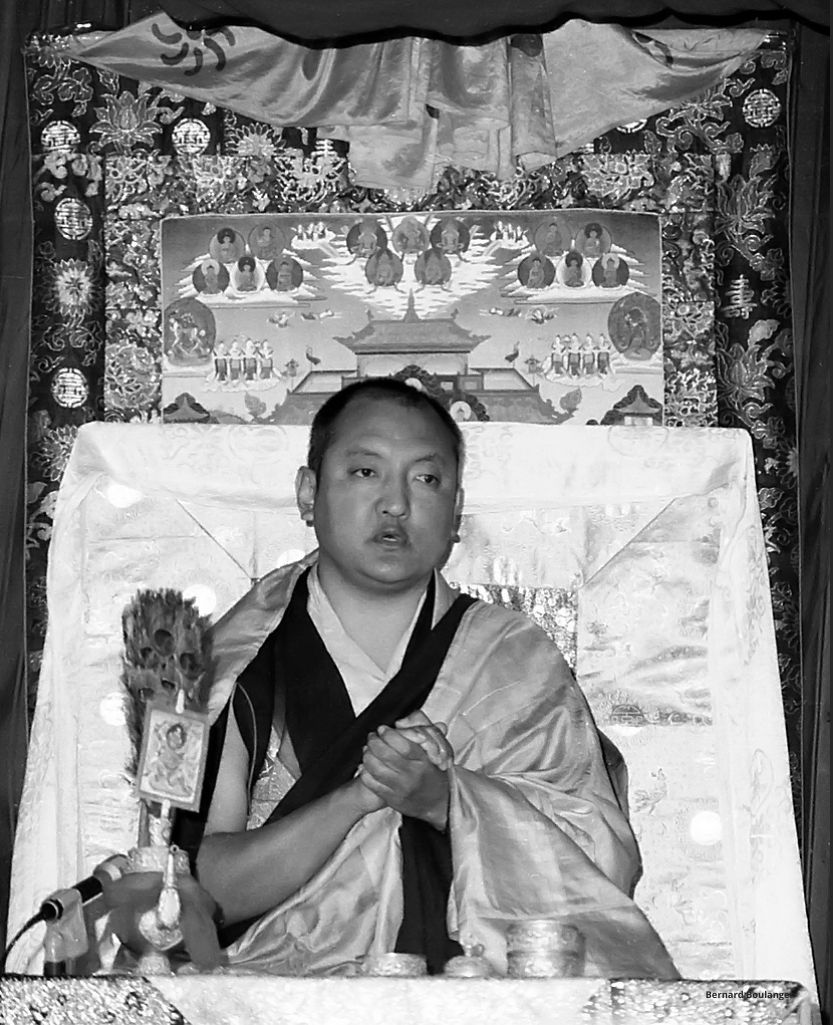In the courtyard of the Lama House, buffeted by the colds spring winds in April 1990, the 14th Kunzig Shamar Rinpoche Mipham Chökyi Lodrö transmitted a major treatise on the stages of Mahahumdra meditation, Moonbeams (Dawe Öser), by Dakpo Tashi Namgyal (1512-1587).[1]
This text belongs to a cycle of three teachings called the Trilogy of Light: Moonbeams, Jewel Light, which clarifies the Secret Mantra Vehicle, and Sunlight, which exhaustively explains Hevajra Tantra. Shamarpa initially wished to put in place study and practice based on these texts.
Mahamudra, Kunzig Shamarpa explains, is a “Sanskrit word composed of two roots: the root maha, which means vast; great, and mudra, which can have many different meanings, such as junction; symbolic gesture. It can also signify seal in its meaning of wish, or authorization of realization—and in this sense, it is the great seal, or great authorization that allows us to achieve realization. In fact, the literal meaning of Mahamudra is supreme authorization, in the sense that, “there is nothing more excellent that can be transmitted by all the tathagatas.”
(From Tendrel Magazine, Issue 23, August, 1990).
Moonbeams, a treatise of over four hundred pages including countless quotations from the sutras, tantras, and oral instructions from the accomplished masters of India and Tibet, presents calm abiding meditation (samatha/shiné) and higher vision (vipasyana/lhaktong) in a first part and the theoretical foundations and practice of Mahamudra in the Kagyüpa tradition in a second part.
“Expressing myself in a simple and understandable way, I will first give the reasons why it is essential to meditate on the true nature of mind. Then I will lay out the gradual steps of this meditation,” writes this Kagyu master who was a contemporary of the 8th and 9th Karmapas and the primary abbot of Dakla Gampo Monastery, founded by Gampopa.
Based on this treatise, Kunzig Shamarpa gives explanations on numerous aspects of the meditation and obstacles that one can encounter in it, notably emphasizing shiné practice, without which, “it is indeed impossible to accomplish any other practice. Based on shiné, the capacity for awareness—the perception of reality as it is—will be able to develop.”
Renounce all physical activity and let your body naturally relax.
Do not talk too much, [for words] are like echoes.
Ignore thought and look at natural consciousness.
Tilopa, as quoted in Moonbeams
Kunzig Shamarpa also reminds us of the two moments of practice, on the cushion and the rest of the time, between meditation sessions, “which must be dedicated to purification and accumulation of positive activities. For this, it is enough to follow the commitments made during the bodhisattva vows, notably the practice of the six paramitas.”
Each afternoon, Lama Jigme Rinpoche reviewed the teaching for numerous disciples coming from all over Europe.
Shamar Rinpoche gave the lung of the text, in other words the ritual reading, specifying that this carries “blessing that allows not only to study the teaching, but also to realize it.”
Furthermore, Rinpoche gave precious advice on the importance of a “lama who is perfectly qualified in the realm of meditation” to transmit Mahamudra instructions. This notably concerns “placing highest importance not on the person but on the authenticity of the teachings, of realizing and understanding the meaning of the teachings through experience.”
During this stay, Rinpoche, who stayed at the center for the first time, conferred Dorje Sempa, Marpa, Karma Pakshi and Amitabha empowerments.
Rinpoche left practitioners with clear instructions,
It is important to avoid materialism and sensational spiritualism that attaches to experiences. Beware the danger of practice that aims to obtain experiences and turn toward practice with the goal of realizing enlightenment. It is the means for becoming a very correct Dharma practitioner.
These photos come from our archives or were collected as part of the research for Dhagpo Kagyu Ling’s 50th anniversary. We have not been able to identify all the authors. The use of these photos is solely for informational purposes within the context of Dhagpo Kagyu Ling’s 50th anniversary celebration. Their use is limited to this event and our website and is not for commercial purposes.
Event
To commemorate this event: April 9, 10, and 11, the audio recordings of Kunzig Shamarpa’s teaching on the Dawe Öser will be streamed in the Institute (in French and English).
This is an in-person event.
The recordings are also available for consultation in the Dhagpo Kagyu Ling Library.
These photos come from our archives or were collected as part of the research for Dhagpo Kagyu Ling’s 50th anniversary. We have not been able to identify all the authors. The use of these photos is solely for informational purposes within the context of Dhagpo Kagyu Ling’s 50th anniversary celebration. Their use is limited to this event and our website and is not for commercial purposes.





















